Find aDomain Search Powered byGoDaddy.com ...
If you plan on placing your ATMs throughout the city, it’s a good idea to map out in advance the route you will take to service them and estimate the frequency of your maintenance.
We earn commissions if you shop through the links below. Read more
Written by: Carolyn Young
Carolyn Young has over 25 years of experience in business in various roles, including bank management, marketing management, and business education.
Published on November 4, 2021
Updated on September 26, 2022
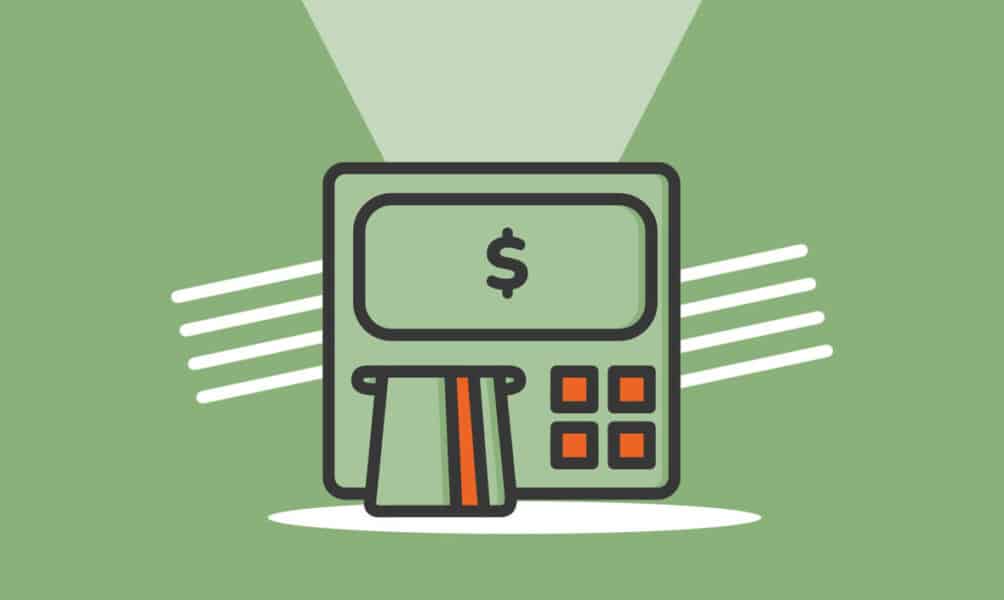
Investment range
$3,550 - $11,100
Revenue potential
$36,000 - $220,000 p.a.
Time to build
0 - 3 months
Profit potential
$29,000 - $66,000 p.a.
Industry trend
Growing
Commitment
Flexible
One automated teller machine, or ATM, can provide its owner with a small stream of passive income. A collection of ATMs placed in heavily trafficked areas, on the other hand, can provide a small business owner with a tidy profit.
Even in today’s digitized world, people still need cash. At the same time, ATM machines have evolved with the addition of improved security measures, foreign currencies, and even cryptocurrencies.
Of course, starting any new business takes time, knowledge, and patience. Read on, move through the launch and development process step by step, and soon you’ll have your own successful business.

The first step is to determine if starting an ATM business is viable for you. Think of it as a way to test the idea’s true potential.
At this point you’ll want to consider the following:
What are the downsides and benefits of launching an ATM business? As a rule of thumb, any viable business idea has more advantages than disadvantages.
Below are some pros and cons of an ATM business:
In many countries around the world, customers still choose cash as their favored payment option due to convenience. Technological advancements mean customers expect faster and more secure withdrawals.
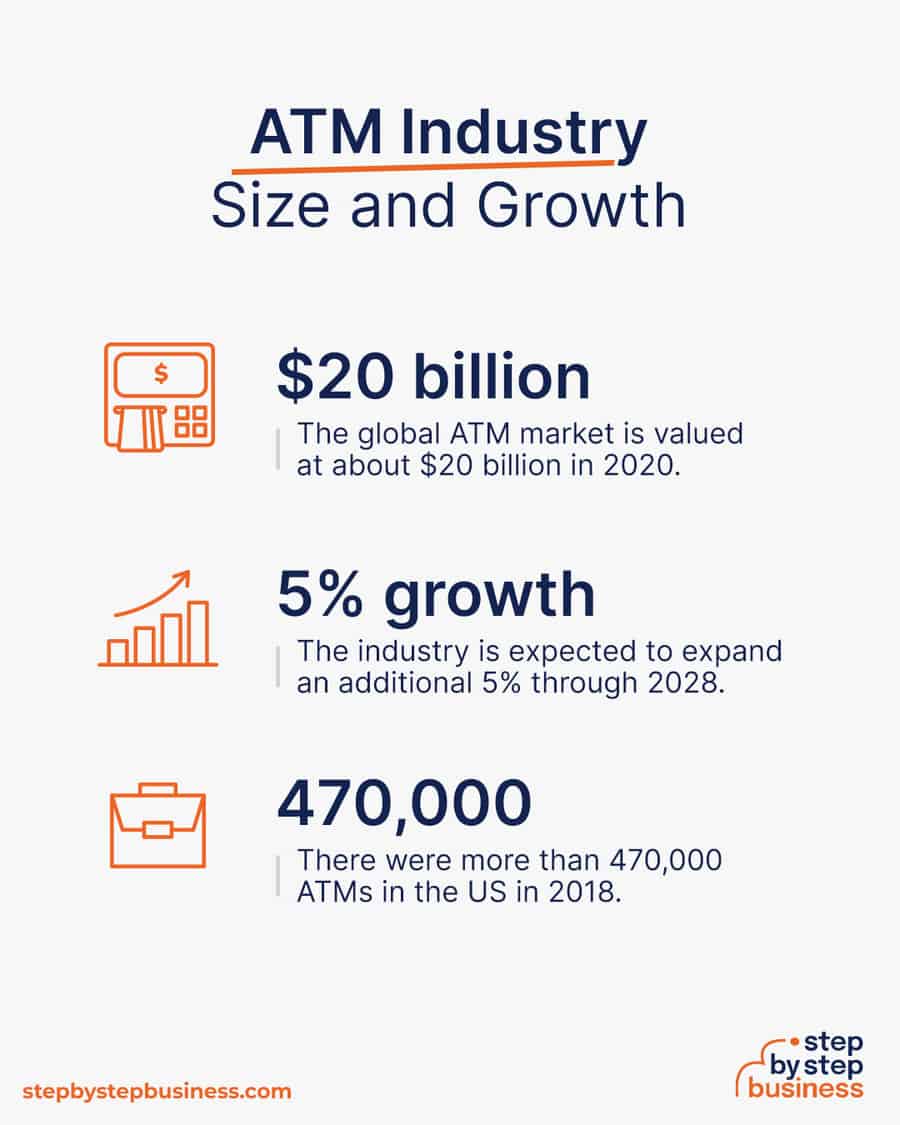
Trends in the ATM industry include:
Challenges in the ATM industry include:
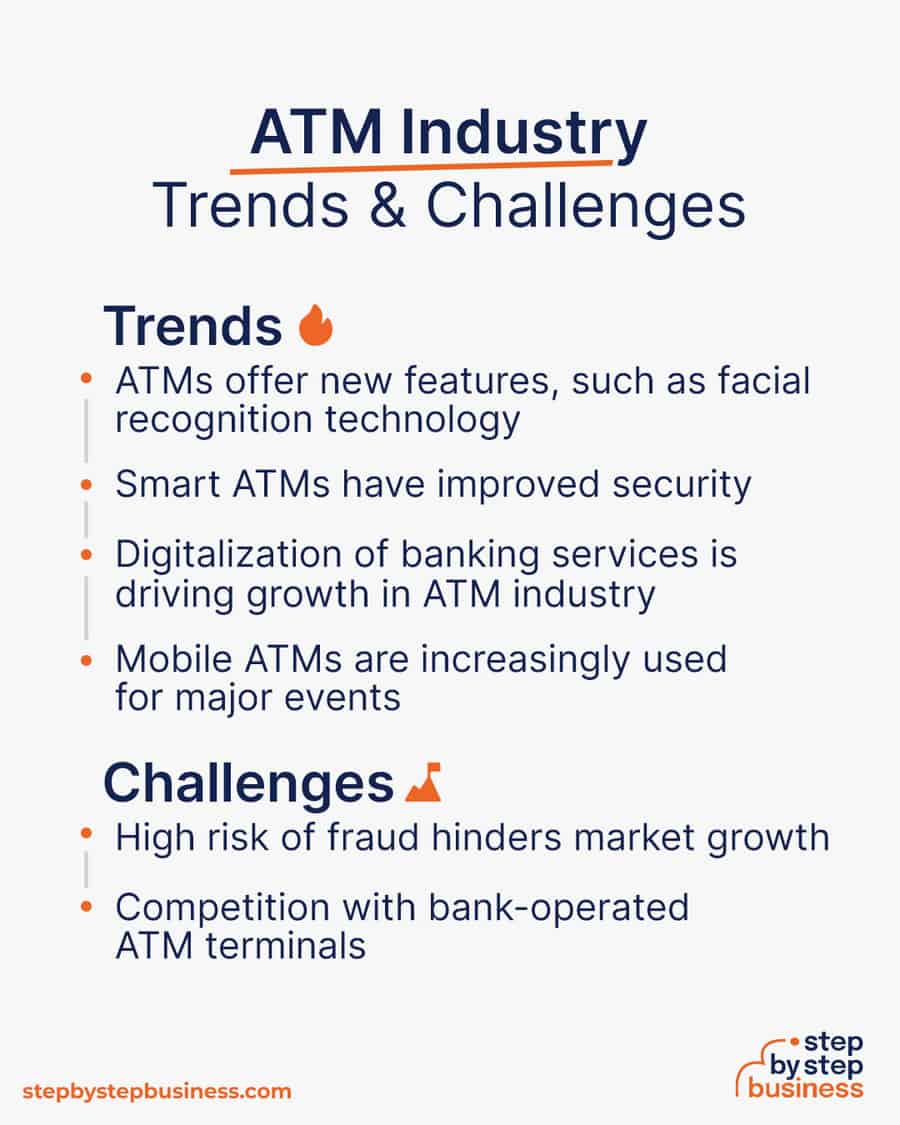
The banks with the largest ATM fleets in the US are:
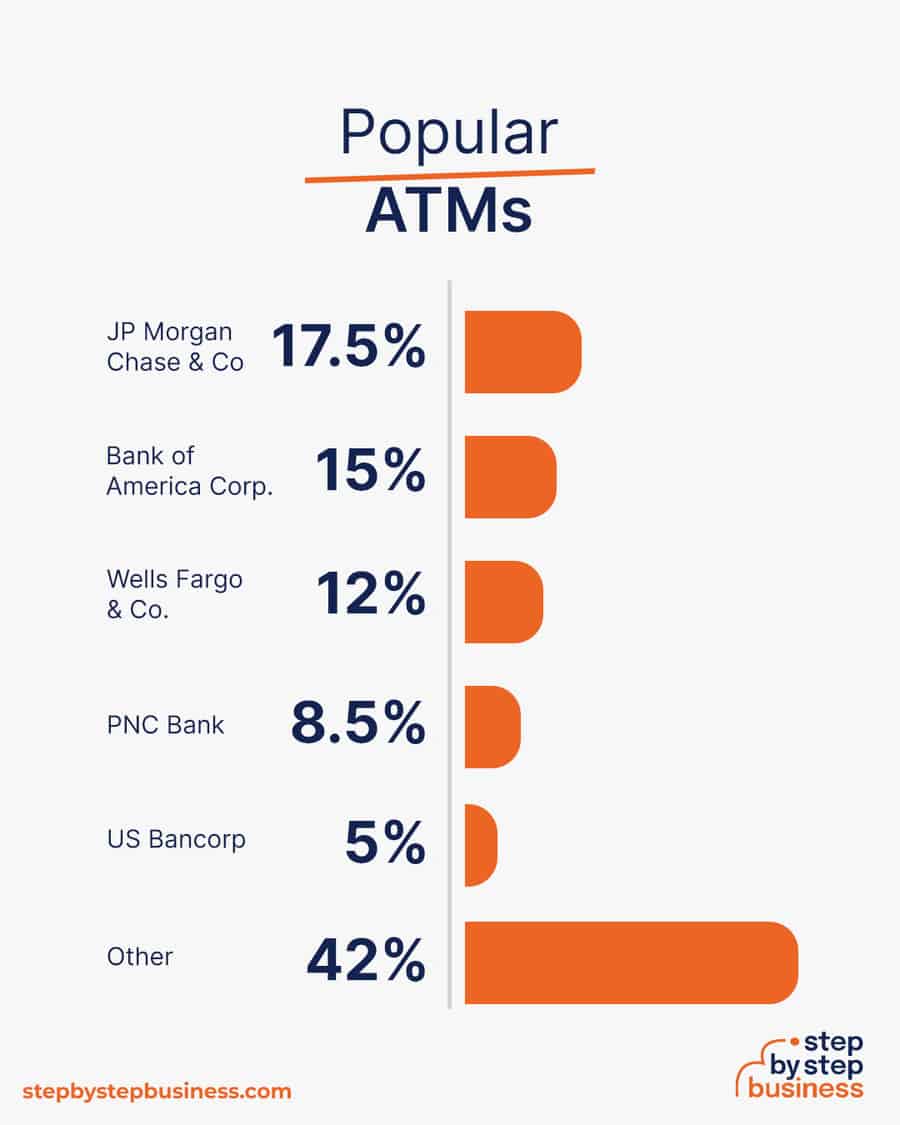
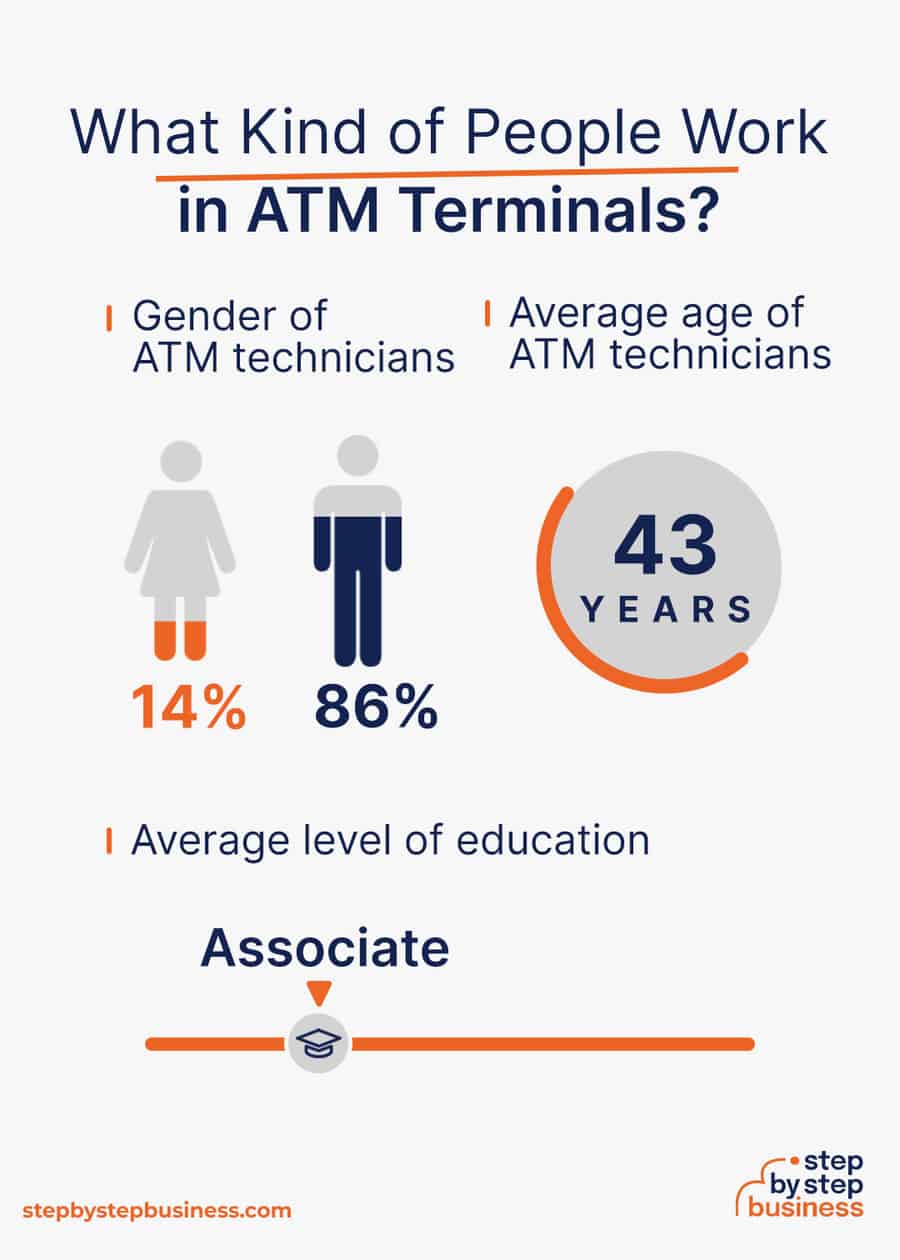
Startup costs for an ATM business range from $3,500 to $11,000. On average, an entrepreneur spends about $7,300 to get an ATM business up and running.
The majority of this initial capital will go towards purchasing your first ATM, which can range from $3,000 to $10,000 each, depending on functionality. Additional fees and marketing costs will also be in order to start your business entity and build your initial branding.
Outside of the ATM itself, you may need some tools and equipment to help you install and service them. Here is a list of items you may need to purchase to get started:
The table below shows a more detailed initial cost breakdown.
| Start-up Costs | Ballpark Range | Average |
|---|---|---|
| ATM | $3,000 - $10,000 | $6,500 |
| LLC or other entity fees | $100 - $200 | $150 |
| Licenses and permits | $150 - $300 | $225 |
| Insurance | $200 - $400 | $300 |
| Marketing costs | $100 - $200 | $150 |
| Total | $3,550 - $11,100 | $7,325 |
Most ATMs charge a user fee of $1 to $3 per transaction, which is the sole source of revenue for the business owner.
Gaming industry veteran Lieberman Companies estimates that one-third of US consumers use an ATM at least once a week, and that ATMs average 6-10 transactions per day. At about $2.50 per transaction, that would mean $20 in daily revenue per ATM. This means that your first ATM machine, assuming it’s well placed and functional 24/7, should pay for itself in less than a year.
In your first year, you could work from home as a solopreneur and install 5 ATMs in good locations, bringing in more than $36,000 in annual revenue if a machine averages 8 transactions a day. If you give the local business $0.50 per transaction, your annual profit would be around $29,000.
In your second year, the average number of daily transactions per ATM could increase to 10, bringing in more than $45,000 in annual revenue and $36,000 in annual profit.
As your brand gains recognition, you could increase your ATM terminals to 20 and raise charges to $3 per transaction. At this stage, you’d rent an office and hire staff, reducing your profit margin to around 30%. With annual revenue of $220,000, you’d make a tidy profit of $66,000.
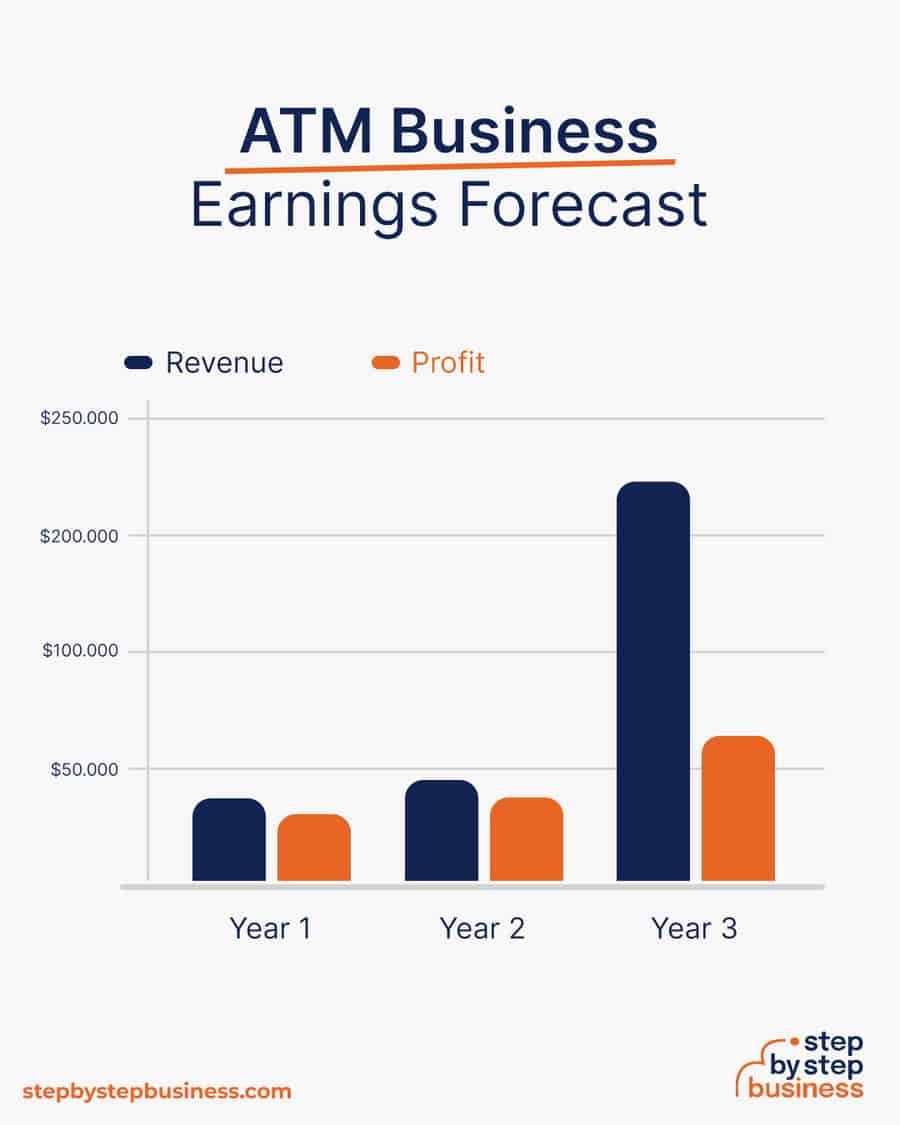
Barriers to entry for an ATM company are relatively low. Significant challenges for new entrants include:

Now that you know what’s involved in starting an ATM business, it’s a good idea to hone your concept in preparation to enter a competitive market.
A prospective ATM business owner should observe their local area and retail outlets to record where ATMs tend to be located and how often people use them.
You should consider possible untapped markets in your area. Maybe there are a few big box stores that have no in-house ATMs? Also, maybe your town is dominated by older ATMs and would respond to an influx of newer, more advanced models with broader functions?
If you plan on placing your ATMs throughout the city, it’s a good idea to map out in advance the route you will take to service them and estimate the frequency of your maintenance.
Additionally, you should consider the security measures you plan to include on your ATMs’ digital interface and on the lockbox you’ll use to transport the cash to your bank. Most ATMs require a minimum weekly balance of around $2,000, which is refilled as needed. A new business owner should perform thorough research on cash requirements and likely demand at the machine’s location.
Finally, think about why you are entering the ATM business. Your main objective should be based on the value of a good ATM: ease of use, efficiency, and security.
There are many different types of ATMs to consider: online or offline, white-label or brown, onsite or offsite, standalone or networked. Industry advisor Greenstar ATM provides a summary, with a short description of each:
Industry advisor ATM Depot outlines the convenience and flexibility of another type of ATM, mobile ATMs, which can be installed almost anywhere. Your ATM business model could include taking several mobile ATMs to local fairs, festivals, sporting events, and other major gatherings to take advantage of temporary intense demand.
Lieberman Companies provides this short guide of ATM types, including a list of the top brands and how to buy your machines. A new ATM business owner would do well to look into the latest in biometric technology and cloud-based functionality concerning ATMs. For your ATM business, you could also consider a leasing or rental operation. ATM businesses like ATM Money Machine and Goldstar ATM, among others, provide ATMs for purchase or lease.
In general, ATM fees are not really a strategic choice for the business owner to make. Their fee levels, as detailed here by market analyst Value Penguin, are determined and restricted to a small range of options by federal laws and regulations. The standard fee is $2-3 per domestic transaction, or $5 plus 3% of the transaction value for international activity.
As a new ATM business owner, consider where cash is the most needed in modern business and entertainment spaces. Beyond banks, consumers need cash at casinos, festivals, concerts, traditional bars, sporting events, hobby shops, and other older retail spaces.
These are some of the most lucrative locations for an ATM, but you might research specific opportunities and markets in your area.
In the early stages, you may want to run your business from home to keep costs low. But as your business grows, you’ll likely need to hire workers for various roles and may need to rent out an office. You can find commercial space to rent in your area on sites such as Craigslist, Crexi, and Instant Offices.
When choosing a commercial space, you may want to follow these rules of thumb:
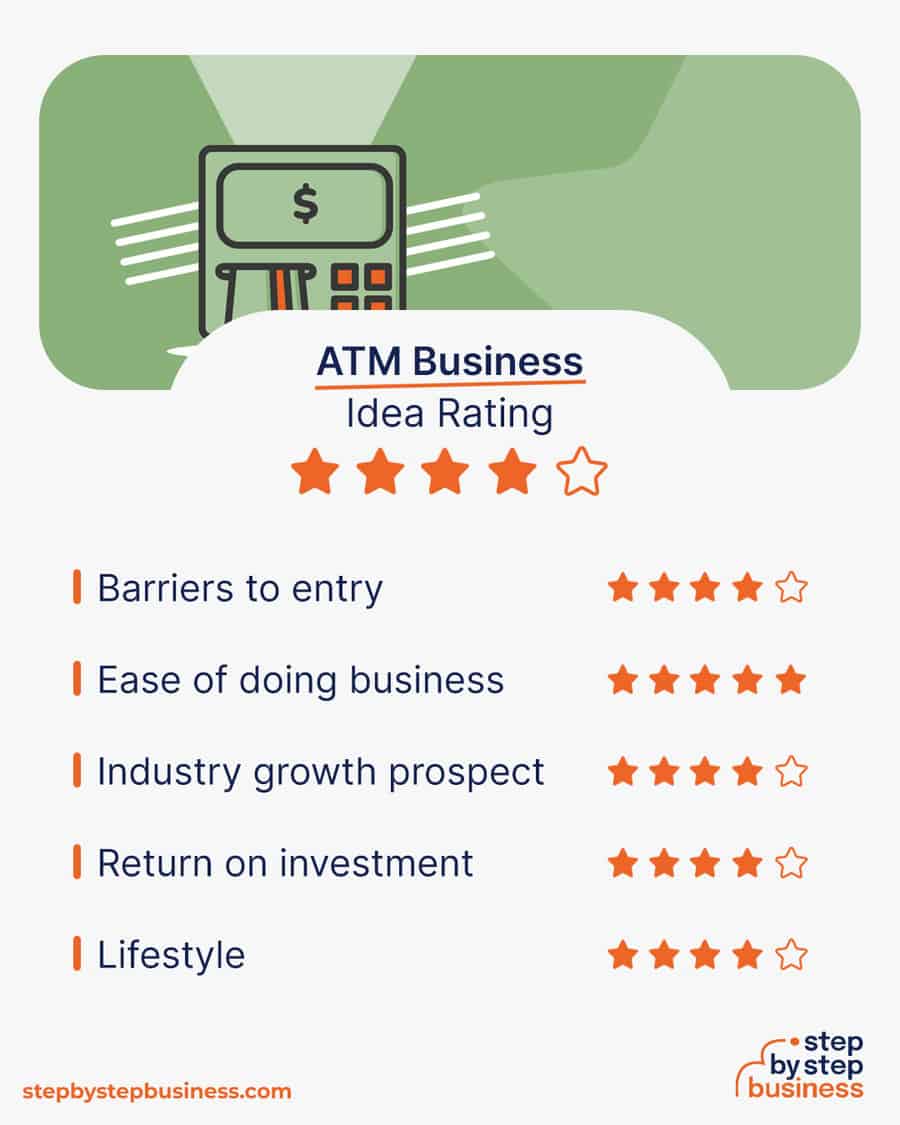

Your business name is your business identity, so choose one that encapsulates your objectives, services, and mission in just a few words. You probably want a name that’s short and easy to remember, since much of your business, and your initial business in particular, will come from word-of-mouth referrals.
Here are some ideas for brainstorming your business name:
Once you’ve got a list of potential names, visit the website of the US Patent and Trademark Office to make sure they are available for registration and check the availability of related domain names using our Domain Name Search tool. Using “.com” or “.org” sharply increases credibility, so it’s best to focus on these.
Finally, make your choice among the names that pass this screening and go ahead with domain registration and social media account creation. Your business name is one of the key differentiators that sets your business apart. Once you pick your company name, and start with the branding, it is hard to change the business name. Therefore, it’s important to carefully consider your choice before you start a business entity.
Every business needs a plan. This will function as a guidebook to take your startup through the launch process and maintain focus on your key goals. A business plan also enables potential partners and investors to better understand your company and its vision:
If you’ve never created a business plan, it can be an intimidating task. You might consider hiring a business plan specialist at Fiverr to create a top-notch business plan for you.

Registering your business is an absolutely crucial step — it’s the prerequisite to paying taxes, raising capital, opening a bank account, and other guideposts on the road to getting a business up and running.
Plus, registration is exciting because it makes the entire process official. Once it’s complete, you’ll have your own business!
Your business location is important because it can affect taxes, legal requirements, and revenue. Most people will register their business in the state where they live, but if you are planning to expand, you might consider looking elsewhere, as some states could offer real advantages when it comes to ATMs.
If you’re willing to move, you could really maximize your business! Keep in mind, it’s relatively easy to transfer your business to another state.
Business entities come in several varieties, each with its pros and cons. The legal structure you choose for your ATM business will shape your taxes, personal liability, and business registration requirements, so choose wisely.
Here are the main options:
We recommend that new business owners choose LLC as it offers liability protection and pass-through taxation while being simpler to form than a corporation. You can form an LLC in as little as five minutes using ZenBusiness’s online LLC formation service. They will check that your business name is available before filing, submit your articles of organization, and answer any questions you might have.

The final step before you’re able to pay taxes is getting an Employer Identification Number, or EIN. You can file for your EIN online or by mail or fax: visit the IRS website to learn more. Keep in mind, if you’ve chosen to be a sole proprietorship you can simply use your social security number as your EIN.
Once you have your EIN, you’ll need to choose your tax year. Financially speaking, your business will operate in a calendar year (January–December) or a fiscal year, a 12-month period that can start in any month. This will determine your tax cycle, while your business structure will determine which taxes you’ll pay.
The IRS website also offers a tax-payers checklist, and taxes can be filed online.
It is important to consult an accountant or other professional to help you with your taxes to ensure you are completing them correctly.
Securing financing is your next step and there are plenty of ways to raise capital:
Bank and SBA loans are probably the best options, other than friends and family, for funding an ATM business. You might also try crowdfunding if you have an innovative concept.


Starting an ATM business requires obtaining a number of licenses and permits from local, state, and federal governments.
Federal regulations, licenses, and permits associated with starting your business include doing business as (DBA), health licenses and permits from the Occupational Safety and Health Administration (OSHA), trademarks, copyrights, patents, and other intellectual properties, as well as industry-specific licenses and permits.
You may also need state-level and local county or city-based licenses and permits. The license requirements and how to obtain them vary, so check the websites of your state, city, and county governments or contact the appropriate person to learn more.
You could also check this SBA guide for your state’s requirements, but we recommend using MyCorporation’s Business License Compliance Package. They will research the exact forms you need for your business and state and provide them to ensure you’re fully compliant.
This is not a step to be taken lightly, as failing to comply with legal requirements can result in hefty penalties.
If you feel overwhelmed by this step or don’t know how to begin, it might be a good idea to hire a professional to help you check all the legal boxes.
Before you start making money, you’ll need a place to keep it, and that requires opening a bank account.
Keeping your business finances separate from your personal account makes it easy to file taxes and track your company’s income, so it’s worth doing even if you’re running your ATM business as a sole proprietorship. Opening a business bank account is quite simple, and similar to opening a personal one. Most major banks offer accounts tailored for businesses — just inquire at your preferred bank to learn about their rates and features.
Banks vary in terms of offerings, so it’s a good idea to examine your options and select the best plan for you. Once you choose your bank, bring in your EIN (or Social Security Number if you decide on a sole proprietorship), articles of incorporation, and other legal documents and open your new account.
Business insurance is an area that often gets overlooked yet it can be vital to your success as an entrepreneur. Insurance protects you from unexpected events that can have a devastating impact on your business.
Here are some types of insurance to consider:


As opening day nears, prepare for launch by reviewing and improving some key elements of your business.
Being an entrepreneur means taking on a lot of different roles and functions, from marketing to accounting. It can get overwhelming and difficult to manage so many diverse activities! Luckily there are a lot of excellent software programs and tools to help you with specific business tasks.
You may want to use industry-specific software, such as MorphisCM, ATM Boss, and STANDER, to manage cash inventory, analyze transaction data, forecast currency usage, and more.
Some of your business will come from the casual passerby or online visitors, but you should still invest in digital marketing! Getting the word out is especially important for new businesses, as it’ll boost customer and brand awareness.
Once your website is up and running, link it to your social media accounts and vice versa. Social media is a great tool for promoting your business because you can create engaging posts that advertise your products:
Take advantage of your website, social media presence and real-life activities to increase awareness of your offerings and build your brand. Some suggestions include:
Website development is crucial because your site is your online presence and needs to convince prospective clients of your expertise and professionalism. They are unlikely to find your website, however, unless you follow Search Engine Optimization (SEO) practices. These are steps that help pages rank higher in the results of top search engines like Google.
You can create your own website using services like WordPress, Wix, or Squarespace. This route is very affordable, but figuring out how to build a website can be time-consuming. If you lack tech-savvy, you can hire a web designer or developer to create a custom website for your business.
Unique selling propositions, or USPs, are the characteristics of a product or service that sets it apart from the competition. Customers today are inundated with buying options, so you’ll have a real advantage if they are able to quickly grasp how your ATM business meets their needs or wishes. It’s wise to do all you can to ensure your USPs stand out on your website and in your marketing and promotional materials, stimulating buyer desire.
Global pizza chain Domino’s is renowned for its USP: “Hot pizza in 30 minutes or less, guaranteed.” Signature USPs for your ATM business could be:

You may not like to network or use personal connections for business gain. But your personal and professional networks likely offer considerable untapped business potential. Maybe that Facebook friend you met in college is now running an ATM business, or a LinkedIn contact of yours is connected to dozens of potential clients. Maybe your cousin or neighbor has been working in banking for years and can offer invaluable insight and industry connections.
The possibilities are endless, so it’s a good idea to review your personal and professional networks and reach out to those with possible links to or interest in ATM. You’ll probably generate new customers or find companies with which you could establish a partnership. Online businesses might also consider affiliate marketing as a way to build relationships with potential partners and boost business.

If you’re starting out small from a home office, you may not need any employees. But as your business grows, you will likely need workers to fill various roles. Potential positions for an ATM business include:
At some point, you may need to hire all of these positions or simply a few, depending on the size and needs of your business. You might also hire multiple workers for a single role or a single worker for multiple roles, again depending on need.
Free-of-charge methods to recruit employees include posting ads on popular platforms such as LinkedIn, Facebook, or Jobs.com. You might also consider a premium recruitment option, such as advertising on Indeed, Glassdoor, or ZipRecruiter. Further, if you have the resources, you could consider hiring a recruitment agency to help you find talent.

Your earnings depend on the number of machines you can deploy. How many ATMs will you be able to purchase and operate? The location of these machines is also important.
Ideally, these machines should be located in areas with high foot traffic, such as retail outlets. But consider installing your machines in areas where there are many unbanked or underbanked consumers, and areas that are not served by the big banks. That way, you’ll also be helping the community by providing the people with convenient access to cash.
Now that you have the knowledge you need to start a business, it’s time to get out there and put your plans into action!
ATM owners make money off the transaction fees added to each ATM withdrawal from the machine. Each time a customer makes a withdrawal from the ATM, the customer agrees to a predetermined fee for the service. The fees vary based on the bank and ATM network, and are charged either at the time or as an item on the customer’s bank statement.
The average ATM processes approximately 300 transactions monthly. At about $2.50 per transaction, the owner would stand to make approximately $750 per month per machine.
The owner / operator of the ATM is responsible for filling the machine with cash on a periodic basis, either through their own team or by hiring a 3rd party provider. The typically minimum weekly balance is around $2,000.

Published on August 16, 2023
Find aDomain Search Powered byGoDaddy.com ...
Read Now

Published on March 16, 2023
Lorem ipsum dolor sit amet, consectetur adipiscing elit, sed do eiusmod tempor incididunt ut labore et dolore magna aliqua. Ut enim ad minim veniam, ...
Read Now

Published on March 10, 2023
When to Use Paychex Flex When to Use QuickBooks Payroll ...
Read Now
No thanks, I don't want to stay up to date on industry trends and news.
Comments